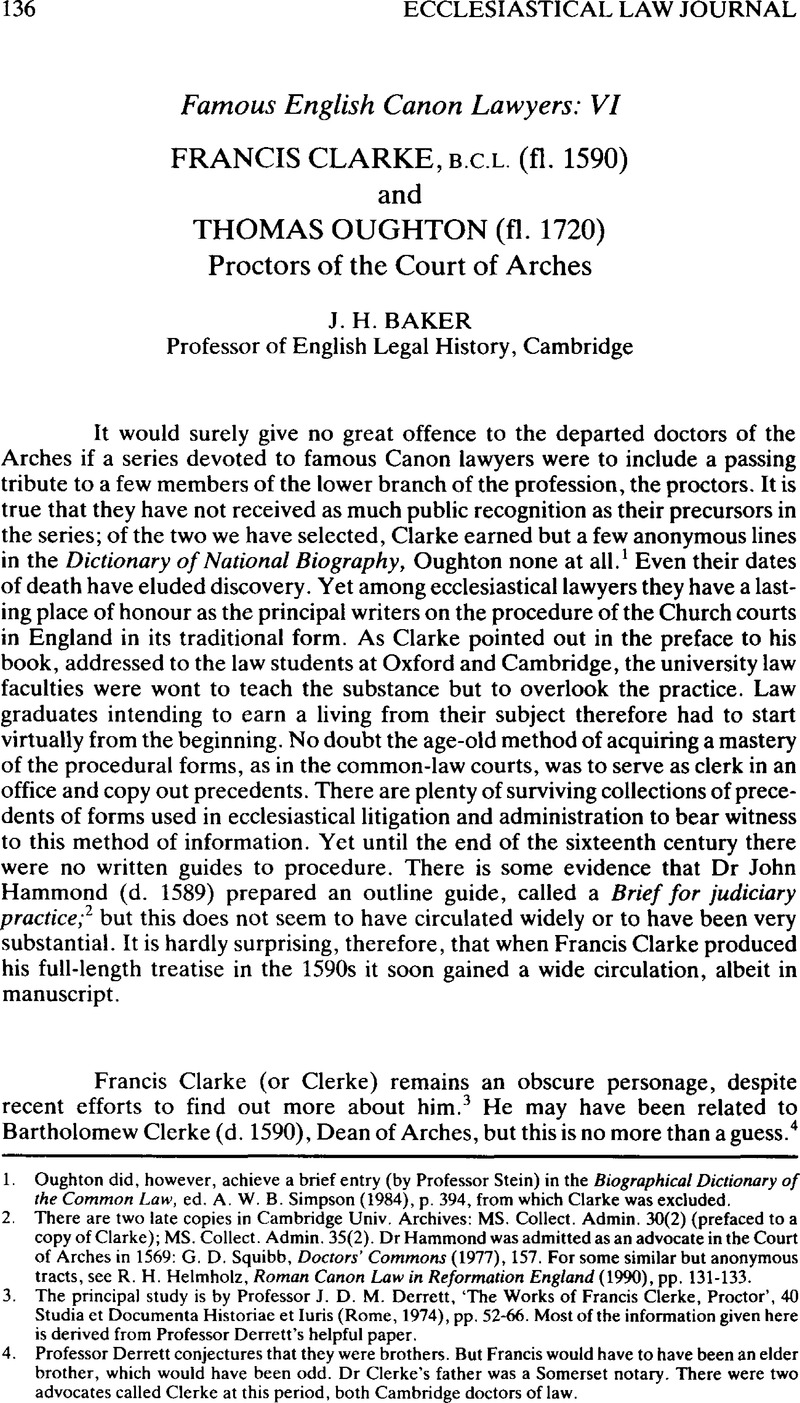No CrossRef data available.
Article contents
Famous English Canon Lawyers: VI Francis Clarke, B.C.L. (fl. 1590) and Thomas Oughton (fl. 1720) Proctors of the Court of Arches
Published online by Cambridge University Press: 31 July 2008
Abstract

- Type
- Research Article
- Information
- Copyright
- Copyright © Ecclesiastical Law Society 1994
References
1. Oughton did, however, achieve a brief entry (by Professor Stein) in the Biographical Dictionary of the Common Law, ed. Simpson, A. W. B. (1984), p. 394Google Scholar, from which Clarke was excluded.
2. There are two late copies in Cambridge Univ. Archives: MS. Collect. Admin. 30(2) (prefaced to a copy of Clarke); MS. Collect. Admin. 35(2). Dr Hammond was admitted as an advocate in the Court of Arches in 1569: Squibb, G. D., Doctors' Commons (1977), 157Google Scholar. For some similar but anonymous tracts, see Helmholz, R. H., Roman Canon Law in Reformation England (1990), pp. 131–133.Google Scholar
3. The principal study is by Professor Derrett, J. D. M., ‘The Works of Francis Clerke, Proctor’, 40 Studia et Documenta Historiae et Iuris (Rome, 1974), pp. 52–66Google Scholar. Most of the information given here is derived from Professor Derrett's helpful paper.
4. Professor Derrett conjectures that they were brothers. But Francis would have to have been an elder brother, which would have been odd. Dr Clerke's father was a Somerset notary. There were two advocates called Clerke at this period, both Cambridge doctors of law.
5. Praxis Curiae Admiralitatis Angliae (1st ed. 1667). Reprinted in 1679, 1722, 1743, 1829. An English translation by Hall, J. E. was included in his Law and practice of the Admiralty (Baltimore 1809).Google Scholar
6. Helmholz adds over 30 MSS. to Derrett's list: Roman Canon Law in Reformation England, pp. 128–129, 196–197.Google Scholar
7. Cambridge Univ. Lib. MS. Dd.2.31; MS. Hh.3.12; MS. Mm.4.30; MS. Add. 4469; Cambridge Univ. Archives MSS. Collect. Admin. 30(6), 31 and 32; Harvard Law School MS. 1050, 1214. 8. Catholic University of America MS. 180.
9. H. E. Huntington Library, San Marino, California, MS. HM 35072.
10. Harvard Law School MS. 1037.
11. Cambridge Univ. Lib. MS. Add. 4469, fo. iv (separate title-page).
12. E.g. Harvard Law School MS. 1037 (copy dated 1666).
13. See Helmholz, , Roman Canon Law in Reformation England, pp. 129–131.Google Scholar
14. The printer was Nathaniel Thompson, for the bookseller John Leach of Castle Street.
15. Cf. Holdsworth, W. S., History of English Law, vol. XII (1938), p. 617Google Scholar, who points out that Consett dates the preface from York and suggests that he practised in the northern province. Consett does not appear to have been a university graduate.
16. Biographical Dictionary of the Common Law, ed. Simpson, A. W. B. (1984), p. 394Google Scholar; lists of proctors in Chamberlayne's Ancient State.
17. Preface to the 1728 ed. The date (1713) is not given, but may be precisely calculated from the list of judges who subscribed.
18. The printer was J. Hooke at the sign of the Golden Rainbow (‘ad Insignem Auratae-Iridis’) in Fleet Street.
19. De ordine judiciorum (Venosa, 1570)Google Scholar. Maranta died in 1530 or 1540.
20. Black gowns were worn in all the lower courts: Floyer, P., The Proctor's Practice (1746 ed.), p. 6.Google Scholar
21. This had been a subject of some controversy. But preaudience was only a practical issue in the Court of Delegates, where members of both professions appeared: Baker, J. H., The Order of Serjeants at Law (1984), pp. 54–55.Google Scholar
22. The writs and records of the common law were still in Latin also.
23. Ordo Judiciorum, vol. I, p. 123Google Scholar, tit lxxx.
24. Preface to the Praxis (‘quos communiter testes (praesertim rustici) non intelligunt’). The duty was cast on the registrar to make sure that the witnesses understood every word that was taken down in Latin.
25. 4 Geo. II, c.26. which took effect from 25 March 1733.
26. There was a Dublin edition in 1795, reprinted 1798.
27. A style bestowed on him by Sir William Scott (later Lord Stowell): Briggs v Morgan (1820) 3 Phill. Ecc. 325 at 329, where he said that Oughton and Godolphin were ‘the oracles of our practice’.
28. Law was not a lawyer. He was the son of George Henry Law (d. 1845), bishop of Bath and Wells, to whom the book was dedicated.




